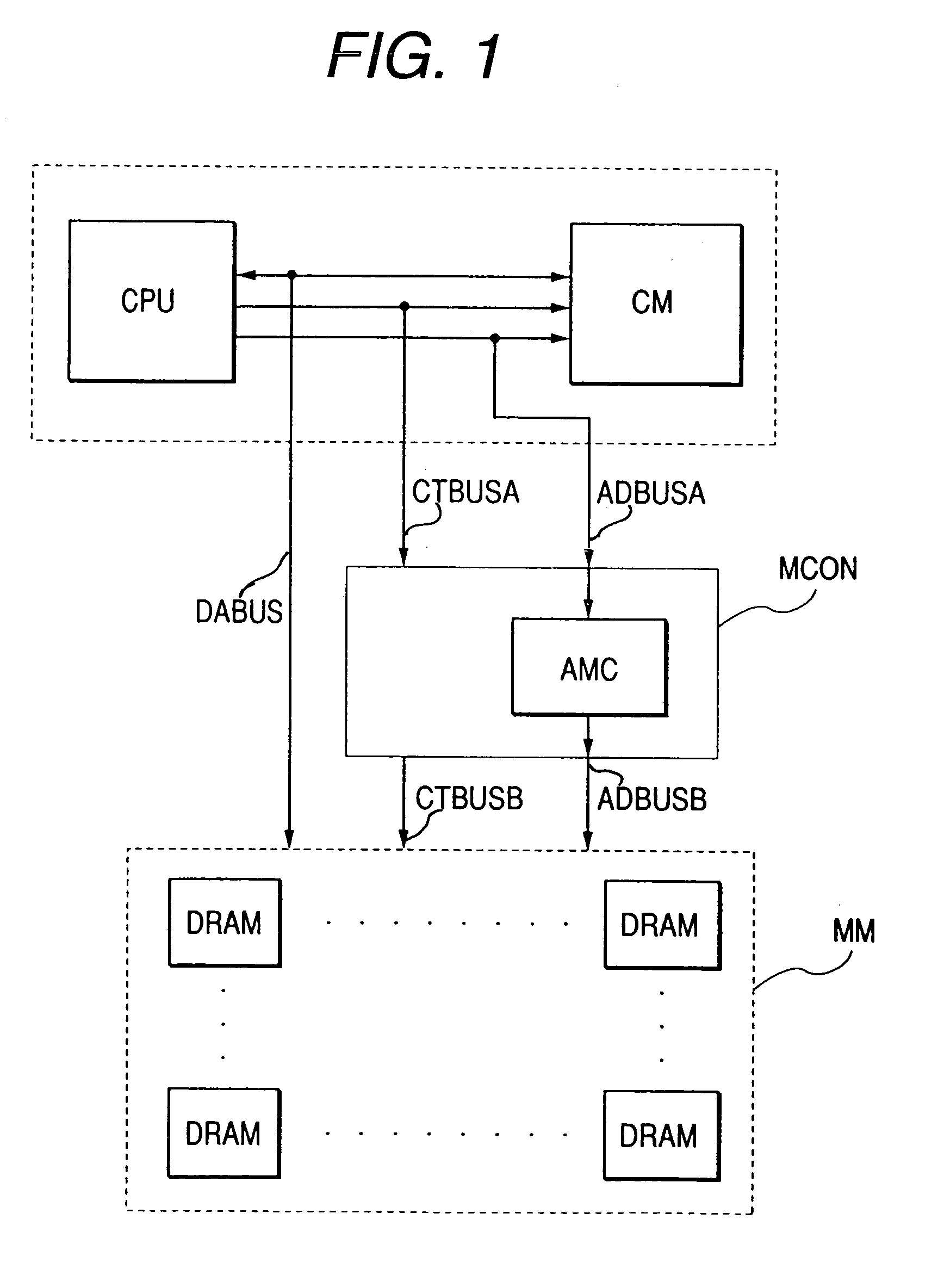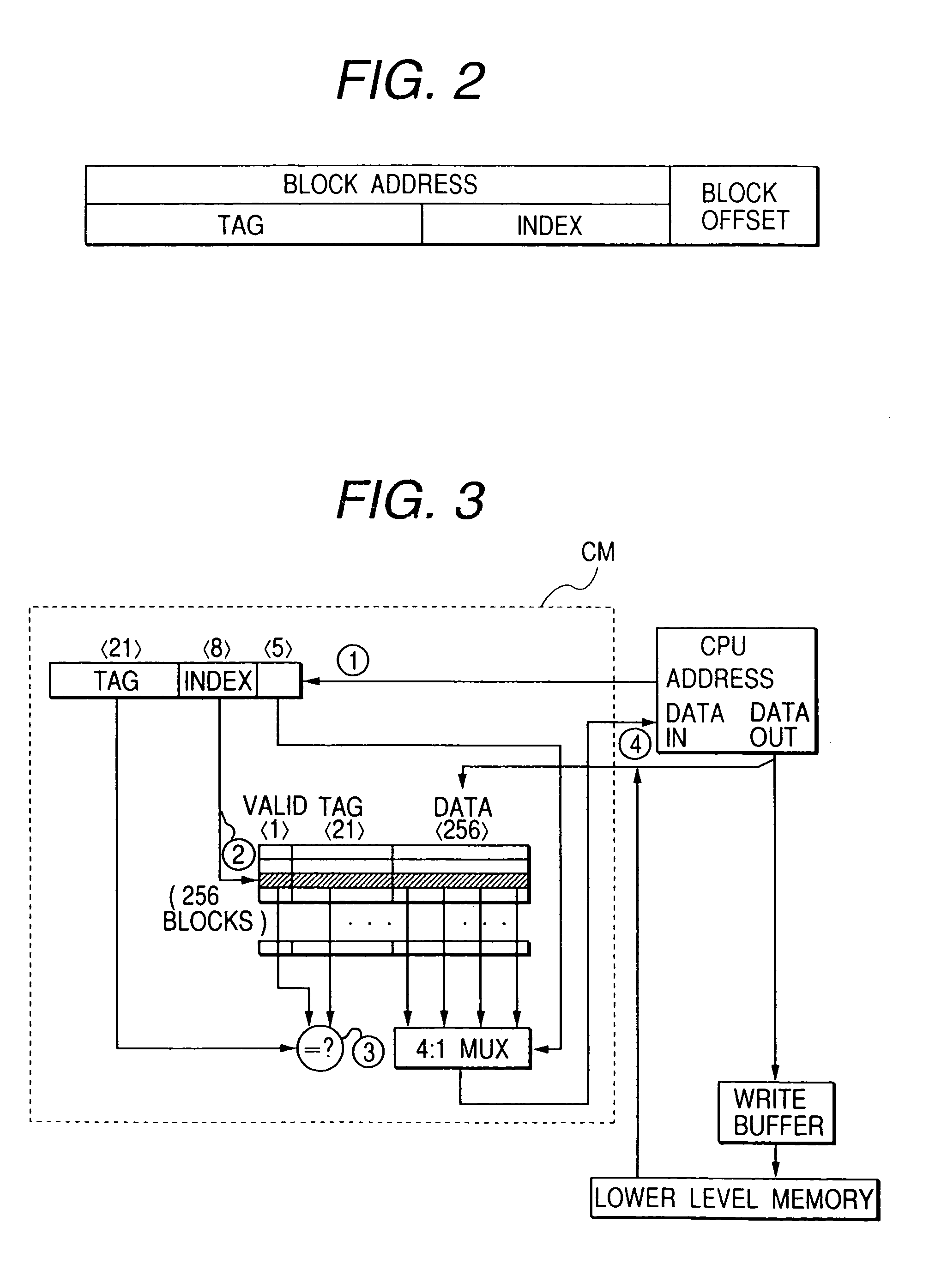Information processing apparatus using index and TAG addresses for cache
- Summary
- Abstract
- Description
- Claims
- Application Information
AI Technical Summary
Benefits of technology
Problems solved by technology
Method used
Image
Examples
embodiment 1
[0027]FIG. 1 is a configurational diagram illustrating the basic concept of the information processing apparatus pertaining to this patent application. This apparatus consists of a cache CM, a CPU, a memory controller MCON involving an address mapping circuit AMC, and a main memory MM comprising one or more DRAMs. A request address from the CPU is communicated to ADBUSA, the CM and the MCON. The request communicated to the CM, after being converted by the AMC into a bank address, a row address and a column address for accessing the DRAM, communicated via ADBUSB to the MM. The description here will refer to a small-scale system for the convenience of explaining address conversion. Accordingly, in the following description, a direct-mapped cache of 128B (in the following description “B” immediately following a numeral denotes “bytes”) in capacity having a block offset of 4 bits (16B). In this example the index consists of 3 bits, and the tag, 23 bits.
[0028]FIG. 4 illustrates an exampl...
embodiment 2
[0033]As stated above, addresses sharing the same index but differing in tag can be assigned to different banks of a DRAM at a high probability without allowing for a bank conflict to arise. As reading and writing at the time of writing back can be assigned to entirely separate banks by extending this address assignment, it is made possible to perform read accessing and write accessing at the time of writing back in the same cycle. An embodiment of this principle will be described below.
[0034]FIG. 7 illustrates another preferred embodiment of the invention according to which, read accessing and write accessing at the time of writing back (accesses giving rise to replacement of cached contents when a cache is missed) are assigned to completely separate banks and thereby reading and writing at the time of writing back are accomplished at the same time. This embodiment consists of a CPU, a cache CM, a main memory MM involving a DRAM, a memory controller MCON for controlling the MM, and...
embodiment 3
[0052]FIG. 13 illustrates another example of application of the present invention to the information processing apparatus of FIG. 7 in a case where a cache having a typical capacity in current use and a DRAM are disposed. Here is supposed a direct-mapped type write-back system wherein the cache has a capacity of 512 KB and a block offset (LINE) of 32B. In this case, LINE consists of 5 bits (0–4), INDEX, 14 bits (5–18), and the remainder, TAG (19–31). On the other hand, the total capacity of the main memory is supposed to be 128 MB, composed of a DRAM having a multi-bank configuration whose capacity is 8 MB. First, supposing that this 128 MB consists of a single chip DRAM, the earlier defined concept of D-TAG can be applied, so that D-TAG consists of 8 bits. This determines the number of independent banks required by this system to be 256. However, as the capacity of a single chip DRAM is 8 MB, far smaller than such a large required capacity, 16 chips are used to compose the main mem...
PUM
 Login to View More
Login to View More Abstract
Description
Claims
Application Information
 Login to View More
Login to View More - R&D
- Intellectual Property
- Life Sciences
- Materials
- Tech Scout
- Unparalleled Data Quality
- Higher Quality Content
- 60% Fewer Hallucinations
Browse by: Latest US Patents, China's latest patents, Technical Efficacy Thesaurus, Application Domain, Technology Topic, Popular Technical Reports.
© 2025 PatSnap. All rights reserved.Legal|Privacy policy|Modern Slavery Act Transparency Statement|Sitemap|About US| Contact US: help@patsnap.com



